Idar
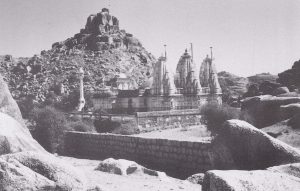 Idar, Digambara Jaina Temple raised on rugged ground high above the town.
Idar, Digambara Jaina Temple raised on rugged ground high above the town.
Idar is a pilgrim’s centre for both Shvetambaras and Digambaras unlike Kumbharia which is exclusively Shvetambara. Its importance as a holy place (tirtha) is confined to being the birth-place of some outstanding acharyas and laymen of distinction. It attracts comparably few visitors, but this should change once Idar’s attractions become better known.
The pilgrim who does not mind the physical exertion of a not too over-arduous ascent part of the trail leads through the basements of the deserted royal castle half-way up the mountain – will, on reaching the end of the trail, be wonder-struck at the sight of two temples.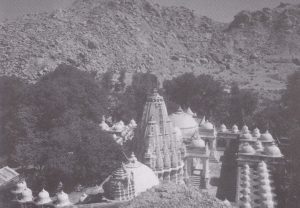
The first one lies perched on a high bed of natural rock, the other partly hidden in a grove of trees and bushes, both watched over by rocky mountain peaks. A grand view, and once again the western traveller to holy Jaina places will be impressed by the Jainas’ lucky hand when it comes to choosing a site for religious worship. Both temples, one Digambara the other Shvetambara, offer facilities for staying overnight.
Idar, having a sizeable Jaina community that bears witness to the town’s long
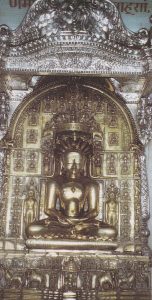 Idar, Shvetambara Shantinatha Temple on the hill. The text below, fastened to the wall near the
Idar, Shvetambara Shantinatha Temple on the hill. The text below, fastened to the wall near the
[entrance, relates the history of the temple.
history as a stopping place on an ancient trade route, was for centuries the seat of a Digambara Bhattaraka. The matha still exists in a fair state of repair. There are libraries with important collections of illustrated old Jaina manuscripts. Scholars associated with the study of such docu- ments are made welcome at Idar.
Up on the mountain, it is the meditative calmness and scenic setting of the two temples that captivate the pilgrim’s mind and heart. In Idar town, at the foot of the mountainous range. it is the temples tucked away in tidy narrow streets which are worth a visit. The sacred images in these shrines have something about them
that seems to be peculiar to Idar – the liking for silver, for instance. Idar is another place yet to be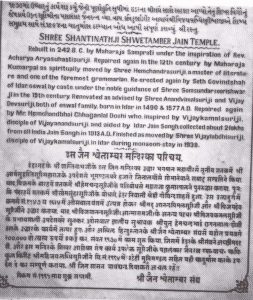 discovered by students of Jaina art. It takes some asking to locate the various temples five Shvetambara and three Digambara – but it is a rewarding pastime to walk the town’s lanes and streets lined with small workshops specialising in handicrafts.
discovered by students of Jaina art. It takes some asking to locate the various temples five Shvetambara and three Digambara – but it is a rewarding pastime to walk the town’s lanes and streets lined with small workshops specialising in handicrafts.
With some luck one may be able to locate the person who has the key to Idar’s famous Jaina library which is known by the name of Anandji-Mangalji-ni Pedhi-na Jnan Bhandara. Its most precious possession is a palm-leaf manuscript depicting thirty-four Kalpa Sutra miniatures ascribed to the last quarter of the four- teenth century.
Idar town. Altarpiece made of metal showing a seated Parshvanatha surrounded by two standing and twenty-two seated Jinas,
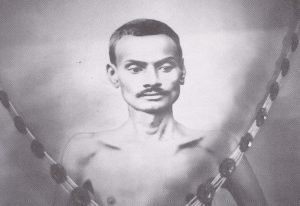 Adorned portrait of Shrimad Rajachandra conspicuously displayed in the main room of the Ashram founded in his memory near Idar in Gujarat.
Adorned portrait of Shrimad Rajachandra conspicuously displayed in the main room of the Ashram founded in his memory near Idar in Gujarat.
THE SHRIMAD RAJACHANDRA ASHRAM AT IDAR
In recent times an ashram in memory of Shrimad Rajachandra, alias Raychandbhai Metha, the teacher and friend of Gandhi, has been built on the crest of a rocky hill about nine kilometres west of Idar. Students of all ages, religions and nationalities who desire to make themselves acquainted with the teaching of this thinker and teacher, as yet little known in the west, are offered board and lodging.
Shrimad Rajachandra was a Sthanakavasi Jaina, which means that there is only a library hall for study and meditation in the ashram, no temple. “The spiritual climax of Rajachandra’s life is regarded by his followers as having taken place on a hill out- side Idur, a small town in north Gujarat.
There he practised intense austerities and preached to seven Shvetambara monks who had become his disciples (…).” (Dundas 1992: 226). Shrimad Rajachandra, author of some books, was born in 1867 in the small Gujarati port of Vavania.
He died early in life in Rajkot in 1901. Considering his life and work as a spiritual teacher, one is inclined to call him a mystic. Many of his letters to friends and disciples have been collected and published.
HE WAS MY REFUGE:
I have tried to meet the heads of various faiths, and I must say that no one ever made on me the impression that [Rajachandra] did. His words went straight home to me. His intellect compelled as great a regard from me as his moral earnestness, and deep down in me was the conviction that he would never willingly lead me astray and would always confide to me his innermost thoughts. In my moments ofspiritual crisis, therefore, he was my refuge.
Mahatma Gandhi
(after Dundas: 1992: 226)
